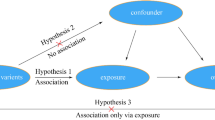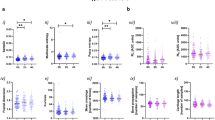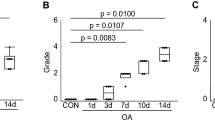Abstract
THE lysosomal system probably plays a key part in the resorption of articular and connective tissues, both in physiological remodelling and during pathological damage1–4. The hypothesis5–7 that lysosomal cathepsin D is primarily responsible for the extracellular and intracellular degradation of the organic matrix of skeletal tissues has been based on strong but circumstantial evidence, and other workers have proposed the involvement of hyaluronidase, cathepsin B and β-xylosidase (reviewed by Barrett8). If the hypothesis that cathepsin D is the enzyme primarily responsible proves to be correct, it has important implications in the pathology of connective tissue disease, particularly rheumatoid arthritis9.
This is a preview of subscription content, access via your institution
Access options
Subscribe to this journal
Receive 51 print issues and online access
$199.00 per year
only $3.90 per issue
Buy this article
- Purchase on SpringerLink
- Instant access to full article PDF
Prices may be subject to local taxes which are calculated during checkout
Similar content being viewed by others
References
Fell, H. B., and Dingle, J. T., Biochem. J., 87, 403 (1963).
Vaes, G., in Lysosomes in Biology and Pathology (edit. by Dingle, J. T., and Fell, H. B.), 1 (North Holland, Amsterdam, in the press).
Dingle, J. T., Fell, H. B., and Coombs, R. R. A., Int. Arch. Allergy Appl. Immunol., 31, 283 (1967).
Dingle, J. T., Glauert, A. M., and Fell, H. B., J. Cell Sci. (in the press).
Dingle, J. T., Proc. Roy. Soc. Med., 55, 109 (1962).
Dingle, J. T., in Rheumatic Diseases (edit. by Duthie, J. J. R., and Alexander, W. R. M.), 80 (Edinburgh University Press, 1968).
Dingle, J. T., in Lysosomes in Biology and Pathology (edit. by Dingle, J. T., and Fell, H. B.), 2 (North Holland, Amsterdam, in the press).
Barrett, A. J., in Comprehensive Biochemistry (edit. by Florkin, M., and Stotz, E. H.), 26B, 425 (Elsevier Publishing Co., Amsterdam, 1968).
Dingle, J. T., in Modern Trends in Rheumatology (edit. by Hill, A. G. S.), 110 (Butterworths, London, 1966).
Lucy, J. A., Dingle, J. T., and Fell, H. B., Biochem. J., 79, 500 (1961).
Di Ferrante, N., J. Biol. Chem., 220, 303 (1956).
Cinader, B., in Antibodies to Biologically Active Molecules (edit. by Cinader, B.), 85 (Pergamon Press, Oxford, 1967).
Author information
Authors and Affiliations
Rights and permissions
About this article
Cite this article
WESTON, P., BARRETT, A. & DINGLE, J. Specific Inhibition of Cartilage Breakdown. Nature 222, 285–286 (1969). https://doi.org/10.1038/222285b0
Received:
Revised:
Issue date:
DOI: https://doi.org/10.1038/222285b0
This article is cited by
-
Inflamed gingivae contain more free lysosomal enzyme
Experientia (1975)
-
Extracellular localization of cathepsin D in ossifying cartilage
Calcified Tissue Research (1973)
-
Fluorescence and histochemical studies of the calcification-initiating lipofuscin type pigment granules in the shell-repair membrane of the snail, Helix pomatia L.
Zeitschrift für Zellforschung und mikroskopische Anatomie (1973)



